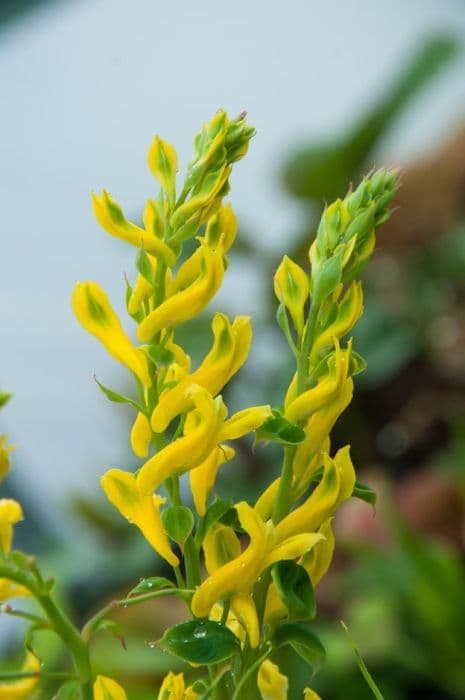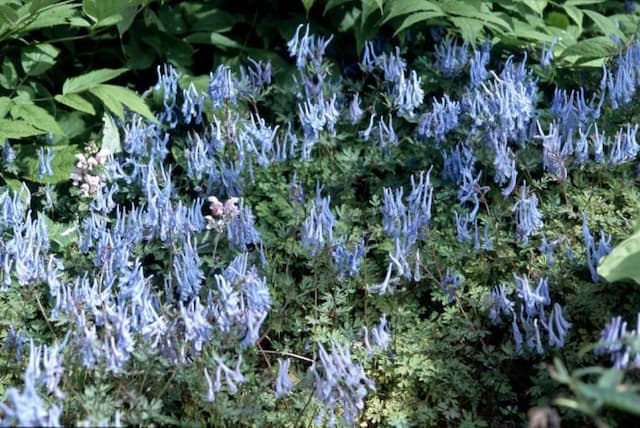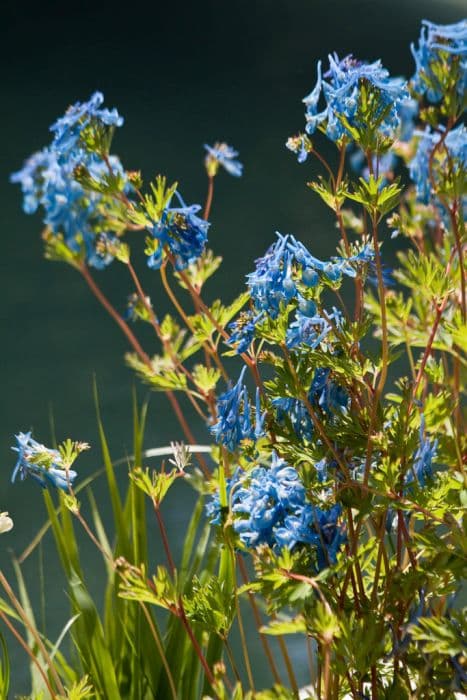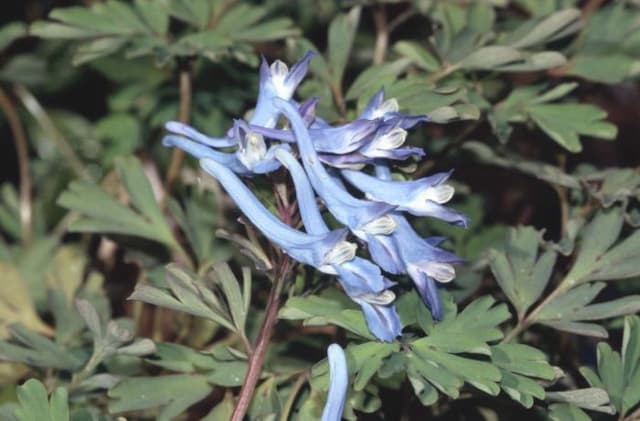Forest Poppy Hylomecon japonica

ABOUT
The plant commonly referred to as forest poppy is an enchanting woodland perennial that captivates with its vibrant floral display. Typically blooming in the early stage of spring, the forest poppy heralds the season's awakening with bright yellow flowers. Each bloom possesses a delicate charm, consisting of four satiny petals that form a cheerful cup shape, inviting admiration and adding a splash of sunshine to the area it inhabits. Surrounding its golden center, the petals of the forest poppy exude a soft radiance, drawing pollinators and the eyes of passersby alike. The foliage of this plant is equally attractive and contributes to its overall elegance. Green leaves are deeply lobed, creating a textured backdrop for the luminous blossoms. These leaves often appear to be softly serrated on the edges, providing a subtle yet intricate visual interest that complements the simplicity of the flowers. As the forest poppy cycles through the seasons, its appearance evolves, but it is the springtime floral display that is most renowned. After the blooms have delighted observers, they give way to the fruiting stage, where seed pods develop, ready to ensure the proliferation of the species in the future. Overall, the combination of its captivating blooms and handsomely lobed leaves makes the forest poppy a cherished plant among those who appreciate the delicate beauty often found in the quiet corners of woodland environments.
About this plant
 Names
NamesSynonyms
Japanese Forest Poppy, Forest Poppy, Celandine Poppy.
Common names
Chelidonium hylomecon, Hylomecon vernalis.
 Toxicity
ToxicityTo humans
The plant commonly known as forest poppy (Hylomecon japonica) is not widely recognized for having significant toxicity to humans. There is limited information available regarding its potential toxic effects, and it does not typically appear on lists of poisonous plants. However, as with any plant, individual sensitivities can vary, and it is generally recommended to avoid ingesting plants that are not commonly consumed as food, as they could cause gastrointestinal discomfort or allergic reactions in sensitive individuals. If someone were to ingest forest poppy and experience negative symptoms, it would be prudent to contact a medical professional or poison control center for guidance.
To pets
Forest poppy (Hylomecon japonica) is not commonly listed as toxic to pets such as dogs and cats. There is no significant evidence to suggest that this plant is harmful to pets, and it does not appear on major toxic plant databases for animals. Nevertheless, pets have varying tolerances and sensitivities to plants, and ingesting non-food plants can sometimes lead to gastrointestinal upset in some animals. If a pet were to ingest part of the forest poppy plant and exhibit symptoms of distress such as vomiting, diarrhea, or abnormal behavior, it would be important to consult a veterinarian for appropriate care and guidance.
 Characteristics
CharacteristicsLife cycle
Perennials
Foliage type
Deciduous
Color of leaves
Green
Flower color
Yellow
Height
1-2 feet (30-60 cm)
Spread
1-2 feet (30-60 cm)
Plant type
Herb
Hardiness zones
5
Native area
Asia
Benefits
 General Benefits
General Benefits- Attracts Pollinators: Hylomecon japonica, also known as forest poppy, provides nectar and pollen for bees and other pollinating insects, promoting biodiversity.
- Aesthetic Appeal: With its bright yellow flowers and attractive foliage, forest poppy adds beauty and color to gardens and natural settings.
- Ease of Care: Forest poppy is relatively easy to care for and is not demanding regarding soil quality or sunlight, making it suitable for various garden settings.
- Early Spring Flowering: As one of the early bloomers, forest poppy provides a welcome splash of color in the garden after the winter months.
- Natural Ground Cover: The plant easily spreads and can provide an effective and natural ground cover, reducing weed growth and soil erosion.
- Resistance to Pests: Forest poppy is generally resistant to many common garden pests, reducing the need for chemical treatments.
- Wildlife Habitat: By forming clumps and ground cover, it offers shelter to small wildlife and beneficial insects.
 Medical Properties
Medical Properties- Anti-inflammatory: Hylomecon japonica has been traditionally used to reduce inflammation.
- Analgesic: There are indications that the plant may have pain-relieving properties.
- Hepatoprotective: Some studies suggest that Hylomecon japonica might have liver-protecting effects.
- Antioxidant: The plant may contain compounds with antioxidant properties, which can help in preventing oxidative stress.
- Wound healing: There is some evidence to suggest that Hylomecon japonica could aid in the healing of wounds.
- Anti-tumor: Preliminary research indicates that the plant may have anti-tumor effects, though more studies are needed.
 Air-purifying Qualities
Air-purifying QualitiesThis plant is not specifically known for air purifying qualities.
 Other Uses
Other Uses- Hylomecon japonica, commonly known as the forest poppy, can be used as a natural dye source, providing a range of yellow to orange hues for fabrics and yarns.
- Due to its ornamental appeal, the forest poppy is often used in woodland gardens to create a naturalized setting.
- The plant can function as a ground cover in shady areas where lawns may struggle to grow, thanks to its spreading habit.
- With its early spring flowers, the forest poppy can be an important nectar source for bees and other early-season pollinators.
- Some cultures may use the petals of the forest poppy in culinary decoration, adding a splash of color to salads and desserts.
- The plant might be used in educational settings, such as school gardens, to teach children about native plants and their ecosystem roles.
- When dried, the seed pods and foliage of the forest poppy can contribute to rustic and natural-themed floral arrangements.
- Photographers and artists may be drawn to the vivid blooms of the forest poppy for their work, making it a subject in nature photography and botanical illustration.
- Gardeners may use the plant as a companion for ferns and other shade-loving plants to create contrasting textures in the landscape.
- The forest poppy, being deer-resistant, can be a strategic choice in areas where deer browsing can be a problem for gardeners.
Interesting Facts
 Feng Shui
Feng ShuiThe plant Hylomecon japonica, commonly known as forest poppy, is not used in Feng Shui practice.
 Zodiac Sign Compitability
Zodiac Sign CompitabilityThe forest poppy is not used in astrology practice.
 Plant Symbolism
Plant Symbolism- Early Bloom - Hylomecon japonica, commonly known as forest poppy, is one of the early bloomers in spring, symbolizing new beginnings and renewal.
- Rarity - As it is not as commonly known as other plants, forest poppy can represent uniqueness and the value of rare beauty.
- Delicate Strength - Despite its delicate appearance, forest poppy can withstand cold climates, symbolizing resilience and inner strength.
- Transience of Life - Like many flowers that bloom briefly, the forest poppy can remind us of the fleeting nature of life and the importance of cherishing each moment.
- Isolation - Sometimes growing in isolated patches in the wild, the forest poppy can symbolize solitude and the need for personal space and introspection.
- Spring Joy - The bright yellow flowers of the forest poppy usher in joy and happiness with the arrival of spring, indicating optimism and the bright side of life.
 Water
WaterJapanese forest poppy should be watered deeply and consistently, especially during its growing season in spring and early summer. The soil should be kept evenly moist, but not waterlogged. It is best to water this plant with approximately 1 gallon of water per week, ensuring that the entire root zone is hydrated. In hotter and drier conditions, you may need to water the plant more frequently, but always check the moisture level of the soil before adding more water. Reduce watering in the fall and winter when the plant goes dormant.
 Light
LightJapanese forest poppy thrives in partial shade to full shade. It should be placed in a spot where it can receive dappled sunlight or light shade throughout the day. Direct afternoon sun can be too intense and may cause the leaves to scorch, so it’s best to situate the plant where it will be protected from strong, direct sunlight.
 Temperature
TemperatureJapanese forest poppy prefers a temperate climate with temperatures ranging from 40 to 70 degrees Fahrenheit for optimal growth. It can survive minimum temperatures down to 20 degrees Fahrenheit but will go dormant in the winter. The ideal temperature conditions are between 50 and 60 degrees Fahrenheit during its active growing period.
 Pruning
PruningPrune Japanese forest poppy to remove spent flowers and damaged or dead foliage to promote new growth and maintain a neat appearance. The best time for pruning is after blooming has finished, usually in late spring or early summer. Pruning too late in the season can disrupt next year's growth, so it's important to do it promptly after flowering.
 Cleaning
CleaningAs needed
 Soil
SoilThe Forest Poppy, or Hylomecon japonica, thrives best in a soil mix that is rich in organic matter, well-draining, and has a slightly acidic to neutral pH between 5.5 and 7.0. A good mix could include equal parts garden soil, peat moss, and perlite or sand to improve drainage.
 Repotting
RepottingForest Poppy plants don't require frequent repotting and can be repotted every 2-3 years or when the plant has outgrown its current container. It's best to repot in the spring as new growth begins.
 Humidity & Misting
Humidity & MistingForest Poppy prefers moderate humidity levels but is tolerant of a range of conditions. It will thrive in a garden setting where humidity levels are typical of the outdoor environment.
 Suitable locations
Suitable locationsIndoor
Place your Forest Poppy in bright, indirect light.
Outdoor
Plant in partial shade; keep soil moist but well-drained.
Hardiness zone
5-9 USDA
 Life cycle
Life cycleHylomecon japonica, also known as the forest poppy, begins its life cycle as a seed, which germinates in early spring in moist, shaded soil. Once sprouted, the seedling grows into a young plant, developing a rosette of leaves close to the ground. The plant then matures and produces distinctive yellow flowers in the spring, typically in April or May, which are pollinated by insects. After pollination, the plant sets seed in the form of a capsule, which ripens and eventually splits open to disperse its seeds. The forest poppy is a perennial herb, which means it dies back to the ground after flowering and seed production, but the root system survives the winter to sprout again the following spring. During its life, the plant expands through rhizomes, allowing for vegetative growth alongside seed propagation.
 Propogation
PropogationPropogation time
Spring to early summer
The ideal time to propagate the Japanese Forest Poppy, Hylomecon japonica, is in the spring or early summer when the plant is actively growing. The most popular method of propagation for this plant is by division. This process involves carefully digging up an established clump of the plant once it has begun to outgrow its space or when you simply want to create new plants. With a sharp knife or spade, split the clump into smaller sections, each with several shoots and a good root system. Replant the divisions promptly at the same depth they were growing previously, spacing them about 12 inches (approximately 30 centimeters) apart to allow for growth. Water the newly planted divisions well to help establish them. This method is favored for its simplicity and effectiveness in creating new, robust plants that will begin to flower within a season or two.









